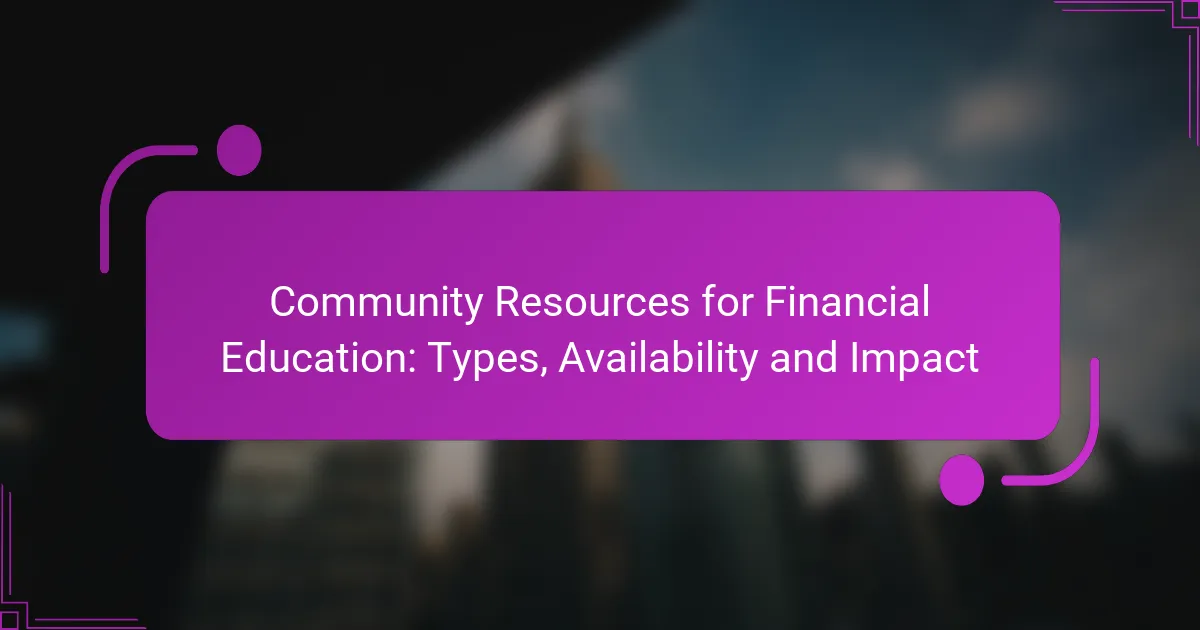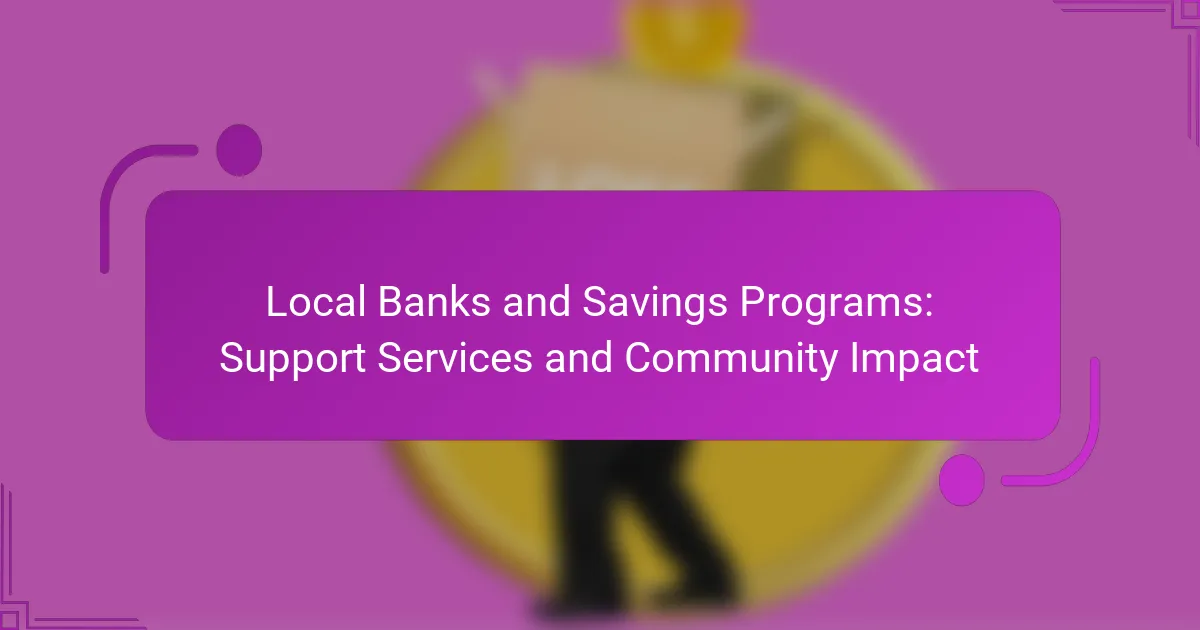Nonprofits play a crucial role in promoting financial literacy by equipping individuals with essential money management skills tailored to diverse demographics, including youth and underserved communities. Through interactive workshops, online resources, and strategic partnerships, these organizations implement effective educational strategies that foster better financial decision-making. The positive outcomes of such programs include enhanced savings rates and improved credit scores, ultimately contributing to individuals’ overall financial well-being.
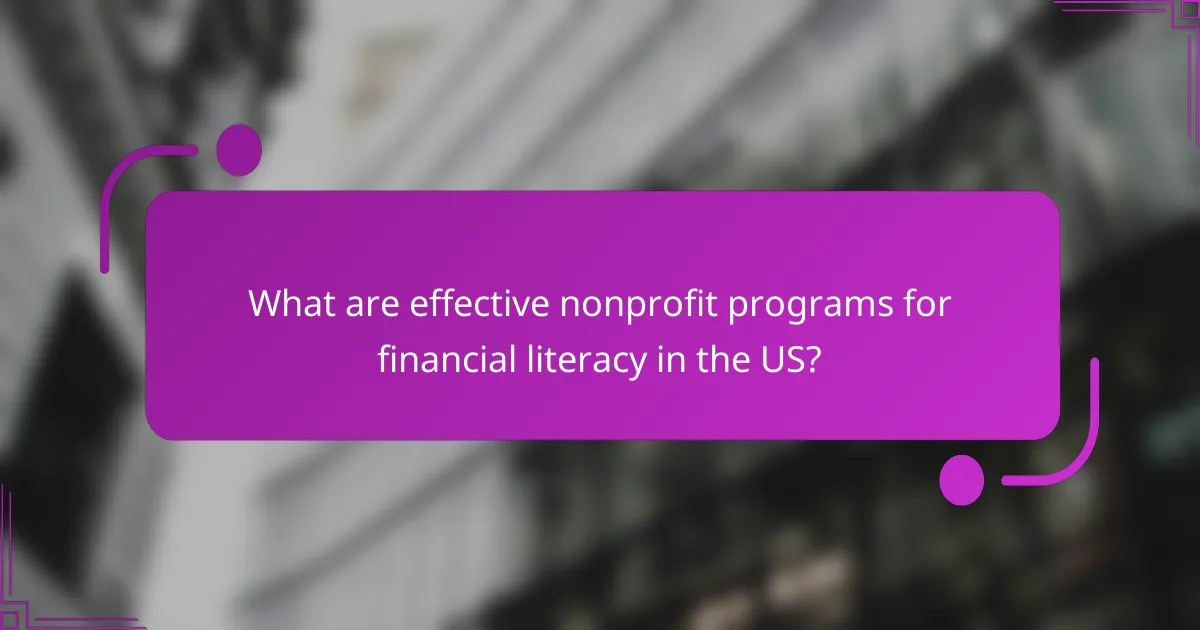
What are effective nonprofit programs for financial literacy in the US?
Effective nonprofit programs for financial literacy in the US focus on empowering individuals with essential money management skills. These programs often target various demographics, including youth and underserved communities, providing practical tools and resources to enhance financial decision-making.
Junior Achievement USA
Junior Achievement USA (JA) offers programs designed to educate students about financial literacy, entrepreneurship, and work readiness. Their curriculum is delivered through hands-on activities and real-world applications, making learning engaging and relevant.
JA programs are typically implemented in schools and after-school settings, reaching millions of students annually. They emphasize practical skills such as budgeting, saving, and investing, helping young people develop a strong foundation for their financial futures.
National Endowment for Financial Education
The National Endowment for Financial Education (NEFE) provides comprehensive resources aimed at improving financial literacy across various age groups. Their programs include free online courses, workshops, and educational materials that cover topics like credit management, retirement planning, and consumer rights.
NEFE’s initiatives are designed to be accessible and adaptable, catering to diverse audiences, including high school students and adults. Their focus on evidence-based practices ensures that the information provided is relevant and effective in fostering financial competence.
Operation HOPE
Operation HOPE focuses on economic empowerment through financial literacy education and support services. Their programs, such as the HOPE Financial Literacy Program, provide individuals with the knowledge and skills necessary to achieve financial independence.
Operation HOPE also offers one-on-one coaching and workshops that address specific financial challenges, such as credit repair and homeownership. By targeting underserved communities, they aim to bridge the financial literacy gap and promote sustainable economic growth.
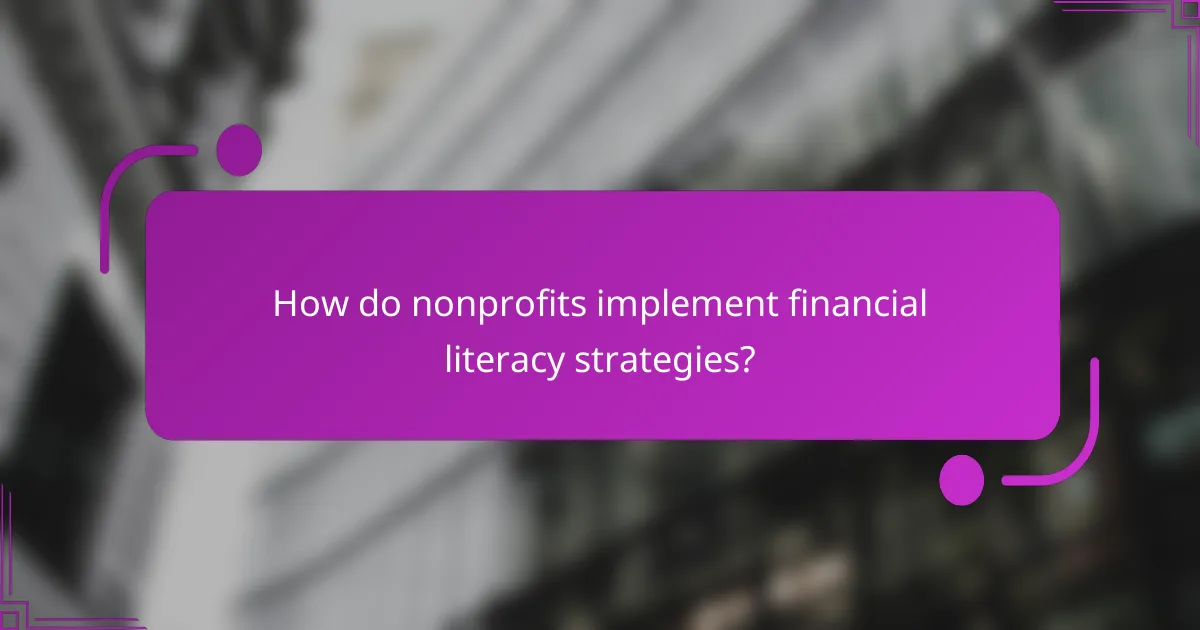
How do nonprofits implement financial literacy strategies?
Nonprofits implement financial literacy strategies through a variety of methods aimed at educating individuals about managing their finances effectively. These strategies often include interactive workshops, online resources, and partnerships with educational institutions to reach a broader audience.
Workshops and seminars
Workshops and seminars are a common approach used by nonprofits to engage participants in hands-on learning about financial topics. These sessions typically cover budgeting, saving, investing, and credit management, providing practical skills that attendees can apply immediately.
Nonprofits often tailor these workshops to specific demographics, such as low-income families or young adults, ensuring the content is relevant and accessible. For example, a workshop might include real-life scenarios to illustrate the impact of financial decisions.
Online resources and tools
Many nonprofits offer online resources and tools to enhance financial literacy. These can include interactive budgeting calculators, educational videos, and downloadable guides that users can access at their convenience. Such resources are particularly beneficial for those who may not be able to attend in-person events.
Additionally, online platforms allow nonprofits to reach a wider audience, breaking geographical barriers. Users can often find resources tailored to their specific needs, such as debt management or retirement planning.
Partnerships with schools
Partnerships with schools are a strategic way for nonprofits to integrate financial literacy into educational curricula. By collaborating with educators, nonprofits can develop programs that teach students essential financial skills from a young age.
These partnerships may involve after-school programs, classroom workshops, or even curriculum development. For instance, a nonprofit might work with a local high school to implement a semester-long course on personal finance, ensuring students graduate with a solid understanding of managing their money.
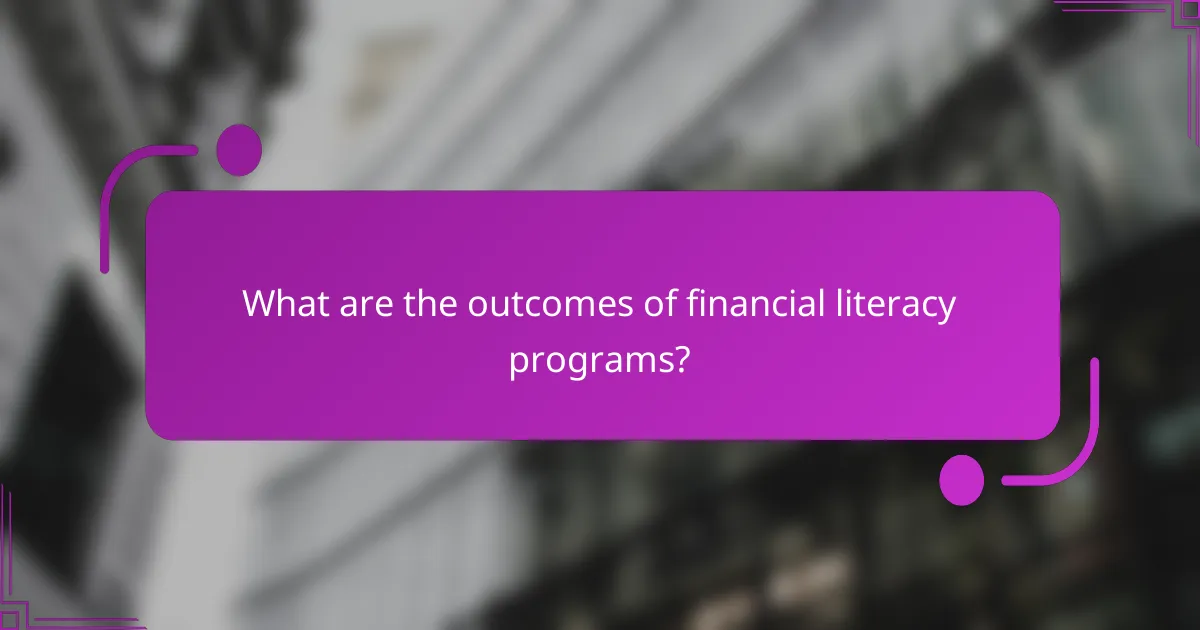
What are the outcomes of financial literacy programs?
Financial literacy programs lead to several positive outcomes, including better financial decision-making, increased savings rates, and improved credit scores. These programs equip individuals with the knowledge and skills necessary to manage their finances effectively, ultimately enhancing their overall financial well-being.
Improved financial decision-making
One of the primary outcomes of financial literacy programs is improved financial decision-making. Participants learn to evaluate their financial options critically, leading to more informed choices regarding budgeting, spending, and investing. For example, understanding the difference between needs and wants can help individuals prioritize their expenses effectively.
Additionally, financial literacy fosters the ability to assess risks and rewards associated with various financial products, such as loans or investment opportunities. This critical thinking can prevent costly mistakes and promote long-term financial health.
Increased savings rates
Financial literacy programs often result in increased savings rates among participants. By teaching budgeting techniques and the importance of setting financial goals, individuals become more motivated to save. For instance, setting up automatic transfers to a savings account can help individuals consistently contribute to their savings without the temptation to spend that money.
Moreover, understanding the benefits of compound interest can encourage individuals to save earlier and more frequently. Even small, regular contributions can lead to significant savings over time, enhancing financial security.
Higher credit scores
Another significant outcome of financial literacy programs is higher credit scores. Participants learn about the factors that influence credit scores, such as payment history, credit utilization, and the importance of maintaining a diverse credit mix. This knowledge empowers individuals to make choices that positively impact their creditworthiness.
For example, individuals who understand the importance of paying bills on time and keeping credit card balances low are more likely to maintain or improve their credit scores. A higher credit score can lead to better loan terms and lower interest rates, ultimately saving money in the long run.
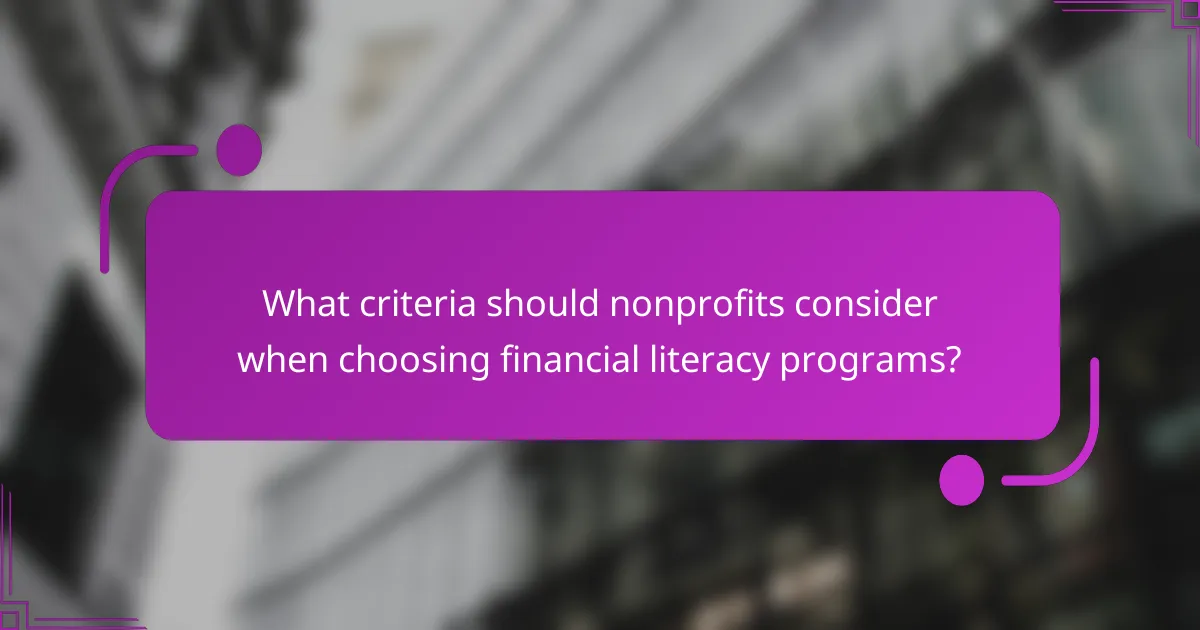
What criteria should nonprofits consider when choosing financial literacy programs?
Nonprofits should evaluate financial literacy programs based on their alignment with community needs, scalability, and the ability to measure outcomes effectively. These criteria ensure that the programs are impactful, sustainable, and provide clear benefits to participants.
Target audience needs
Understanding the specific needs of the target audience is crucial for selecting effective financial literacy programs. This involves assessing the demographics, financial backgrounds, and learning preferences of the community served. For instance, programs aimed at low-income families may focus on budgeting and saving, while those for young adults might emphasize credit management and student loans.
Engaging with the community through surveys or focus groups can provide valuable insights into what topics are most relevant. Tailoring programs to address these needs increases engagement and retention, leading to better educational outcomes.
Program scalability
Scalability is an essential factor for nonprofits when choosing financial literacy programs. A scalable program can be expanded to reach more participants without a proportional increase in costs or resources. For example, a workshop format that can be easily replicated in different locations or adapted for various audiences is more scalable than a one-on-one coaching model.
Nonprofits should consider whether the program can be delivered online or in hybrid formats, which can significantly enhance reach. Additionally, partnerships with local organizations can facilitate broader implementation and resource sharing.
Measurable outcomes
Establishing measurable outcomes is vital for assessing the effectiveness of financial literacy programs. Nonprofits should define clear metrics to evaluate participant progress, such as improved budgeting skills or increased savings rates. These metrics can be qualitative, like participant feedback, or quantitative, like pre- and post-program assessments.
Regularly tracking these outcomes helps organizations refine their programs and demonstrate impact to stakeholders. Utilizing tools like surveys or financial tracking apps can aid in collecting relevant data efficiently.
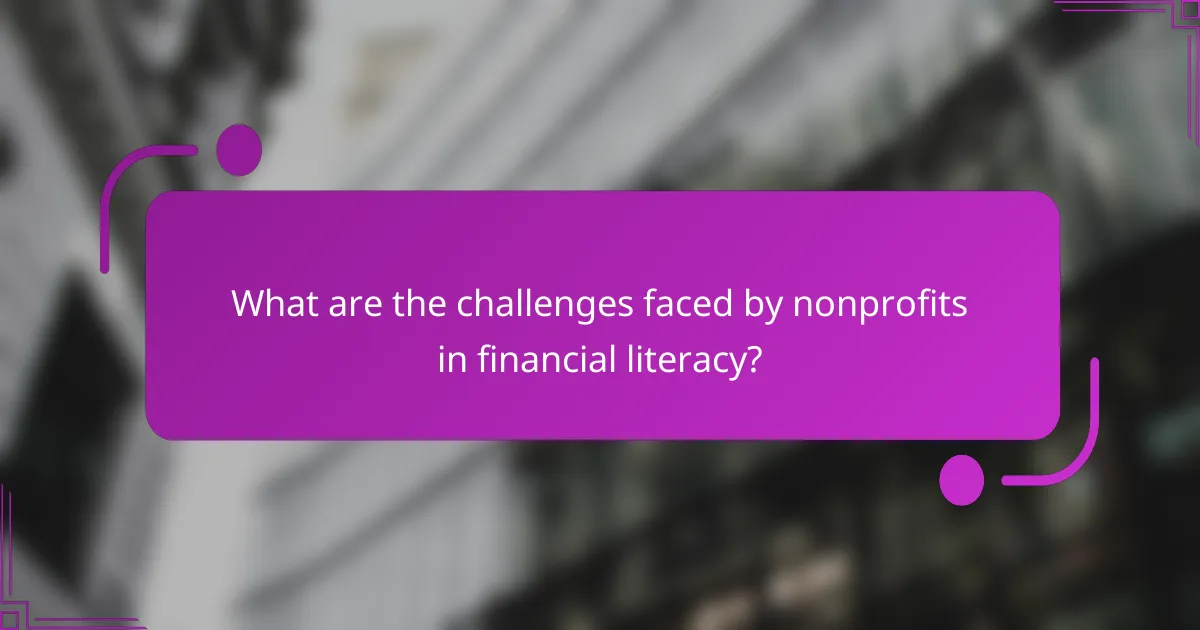
What are the challenges faced by nonprofits in financial literacy?
Nonprofits focused on financial literacy encounter several significant challenges that can hinder their effectiveness. These include limited funding, which restricts program development, and difficulties in engaging target demographics, which can affect outreach and participation.
Funding limitations
Funding limitations are a primary challenge for nonprofits in financial literacy. Many organizations rely on grants, donations, and sponsorships, which can be unpredictable and insufficient to cover operational costs. This often leads to reduced program offerings or the inability to scale successful initiatives.
To navigate funding challenges, nonprofits should diversify their funding sources. This can include applying for government grants, partnering with local businesses, or launching crowdfunding campaigns. Establishing a strong case for support that highlights the impact of financial literacy can also attract more donors.
Engagement with target demographics
Engaging target demographics is crucial for the success of financial literacy programs. Nonprofits often struggle to connect with individuals who may benefit the most, such as low-income families or underserved communities. Tailoring programs to meet the specific needs and preferences of these groups is essential.
Effective strategies for engagement include using culturally relevant materials, offering workshops at convenient times, and leveraging local community centers for outreach. Building trust through partnerships with community leaders can also enhance participation and ensure that programs are well-received.

